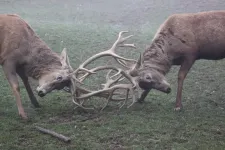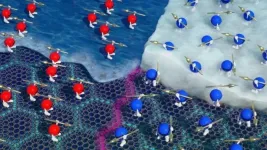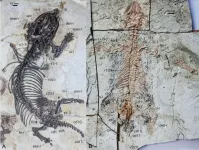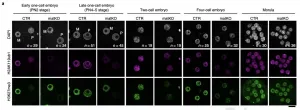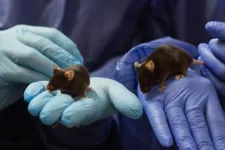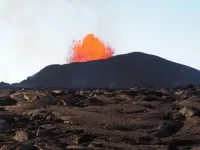(Press-News.org) An international team of researchers has studied individual differences in the behaviour of red deer. They found that several observed behaviours form a personality component, which they labelled "Confidence/Aggressiveness".
As is commonly known, individual people behave consistently different from each other and these kinds of consistent differences in behaviour are called personality. Studies on species other than humans, from insects to elephants, have found that personalities are widespread in nature.
The team consists of researchers from the Czech University of Life Sciences Prague, the University of South Bohemia, Czech Republic, the University of Vienna, Austria, and the University of Turku, Finland and is led by Bruno Esattore from the Department of Ethology at the Institute of Animal Science in Prague. The team of researchers studied personality of red deer with a newly developed questionnaire, as well as observed their behaviours.
The researchers identified a single personality component related to Confidence/Aggressiveness. Interestingly, some of the behaviours making up this component were linked with dominance behaviour in red deer. The study has just been published in Behavioural Processes.
- Many personality studies have focused on primates, rodents, birds, field crickets or fish. Despite of their well-studied biology and increasing popularity in the farming sector, the personality structure of one of Europe's most iconic mammals, the red deer, has until now been unknown, says the lead author of the study Bruno Esattore.
The personality data were collected by using a novel questionnaire for which experienced observers rated 15 behaviours on a scale from 1 to 5, with 1 meaning the deer shows this behaviour "Almost never" and 5 meaning "Most of the time".
- We think it is extremely interesting that inter-individual differences which have been so far overlooked or even regarded as distracting are those that eventually make the difference when trying to identify the personality of these animals, states Doctoral Candidate Laura Saggiomo from the Faculty of Forestry and Wood Sciences of the Czech University of Life Sciences Prague.
- These findings are exciting, but of course, they are not the final picture of how personality manifests in red deer, says Postdoctoral Researcher Vedrana Šlipogor from the Department of Zoology of the University of South Bohemia in Budweiss, Czech Republic.
The team put lots of care into the making of the questionnaire, however, for a majority of the 15 behaviours the observers did not agree very well on their ratings of the deer.
- This was an unexpected result and shows that we have to be careful with our behavioural descriptions and to consider observer perceptions when using questionnaire ratings of animal behaviour for scientific studies, Šlipogor further states.
The team then linked these findings with observations of the dominance interactions of the male deer in their bachelor groups.
- We found no relationship between deer's dominance and personality, but dominance was related to some of the rated behaviours, showing our personality questionnaire captured some biologically meaningful variation, says Bruno Esattore.
Studies on animals kept in zoos or different facilities or farms have shown that knowing the individual characteristics or personalities of animals can help to implement the best strategy in guaranteeing their welfare.
- Personality has not been largely considered in welfare management decisions, but lately it is receiving more and more attention. We believe that studies like ours can help to add to the improvement of animal management and welfare, concludes Martin Seltmann from the Department of Biology at the University of Turku.
INFORMATION:
Cardiovascular diseases are usually complex and affect multiple organs simultaneously. Treatments for vascular diseases in the brain may therefore have implications for the treatment of cardiac diseases. It is therefore important to understand the respective causes and effects. This study explores the causes of intracerebral haemorrhages and links them to the risk of stroke associated with atrial fibrillation. It suggests a fundamental new assessment of the effects of blood thinning on intracerebral haemorrhages.
About 1,000 patients with intracerebral haemorrhage are treated at stroke units each year in Switzerland. Intracerebral haemorrhages are more often fatal than other forms of strokes, ...
Most materials go from being solids to liquids when they are heated. One rare counter-example is helium-3, which can solidify upon heating. This counterintuitive and exotic effect, known as the Pomeranchuk effect, may now have found its electronic analogue in a material known as magic-angle graphene, says a team of researchers from the Weizmann Institute of Science led by Prof. Shahal Ilani, in collaboration with Prof. Pablo Jarillo-Herrero's group at the Massachusetts Institute of Technology (MIT).
This result, published today in Nature, comes thanks to the first ever measurement of electronic entropy in an atomically-thin two dimensional ...
For those who live in an area blighted by ticks, the threat of Lyme disease can cast a shadow over the joy of spring and summer. These blood-sucking arachnids can transmit bacteria into the bloodstream of their unsuspecting host, causing the disease. Early treatment is essential, but current tests are not usually sensitive enough to detect the disease in early-stage patients. A recent study in open-access journal END ...
A joint research team led by Dr. MAO Fangyuan and Dr. ZHANG Chi from the Institute of Vertebrate Paleontology and Paleoanthropology (IVPP) of the Chinese Academy of Sciences and Prof. MENG Jin from the American Museum of Natural History have discovered two new species of mammal-like, burrowing animals that lived about 120 million years ago in what is now northeastern China.
The new species, described in Nature on April 7, are distantly related. However, they independently evolved traits to support their digging lifestyle. They represent the first "scratch diggers" discovered in this ecosystem.
"There are many hypotheses about why animals dig into the soil and live underground," said Prof. MENG, lead author of the study. "For protection against predators, ...
A recent study finds that unhealthy eating behaviors at night can make people less helpful and more withdrawn the next day at work.
"For the first time, we have shown that healthy eating immediately affects our workplace behaviors and performance," says Seonghee "Sophia" Cho, corresponding author of the study and an assistant professor of psychology at North Carolina State University. "It is relatively well established that other health-related behaviors, such as sleep and exercise, affect our work. But nobody had looked at the short-term effects of unhealthy eating."
Fundamentally, the researchers had two questions: Does unhealthy eating behavior affect you at work the next day? And, if so, why?
For the study, ...
An epigenetic study at the RIKEN Center for Integrative Medical Sciences shows that in mouse egg cells, modifications to histone H2A at lysine 119 lay the groundwork for inherited DNA functional modifications from the mother.
In books and the movies, a group of people on a special mission always sends out a scout to do reconnaissance before they proceed. Sometimes, the scouts leave signs or markers that allow the group to know where there should go. Researchers led by Azusa Inoue at the RIKEN Center for Integrative Medical Sciences in Japan have discovered a mark left behind in unfertilized egg cells that determine which DNA modifications ...
In Norway, all newborn children are tested for 25 rare genetic diseases through the Newborn Screening program, and the most common of these is phenylketonuria (abbreviated to PKU), known as Folling Disease.
Every year, between 3-7 children are born in Norway with PKU, and this diagnosis has a great impact on the rest of their lives. People with PKU must follow a very strict diet all their lives, where they must avoid almost all foods that contain proteins.
"Failure to implement the diet from birth may result in irreversible physical problems and brain damage, and optimal brain function requires life-long adherence", explains Professor ...
In a new paper published in the Journal of Environmental Policy & Planning, the University of Maryland teamed up with local researchers to examine green infrastructure adoption and leadership in Tucson, Arizona, an interesting case study where grassroots efforts have helped to drive policy change in a growing urban area surrounded by water-constrained desert. Green infrastructure (any installation that manages water or environmental factors, such as rain gardens, stormwater basins, or urban tree cover) is slowly transitioning from a fringe activity to an important part of the way governments and municipalities are dealing with water and the local effects of a changing climate. By examining ...
Tumors consume glucose at high rates, but a team of Vanderbilt researchers has discovered that cancer cells themselves are not the culprit, upending models of cancer metabolism that have been developed and refined over the last 100 years.
Instead, non-cancer cells in a tumor -- primarily immune cells called macrophages -- have the highest glucose uptake, the group reported April 7 in the journal Nature. The findings that different cells in the tumor microenvironment use distinct nutrients according to their own metabolic programs could be exploited to develop new therapies and imaging strategies, ...
Washington, DC-- The 2018 eruption of Kīlauea Volcano in Hawai'i provided scientists with an unprecedented opportunity to identify new factors that could help forecast the hazard potential of future eruptions.
The properties of the magma inside a volcano affect how an eruption will play out. In particular, the viscosity of this molten rock is a major factor in influencing how hazardous an eruption could be for nearby communities.
Very viscous magmas are linked with more powerful explosions because they can block gas from escaping through vents, allowing pressure ...
